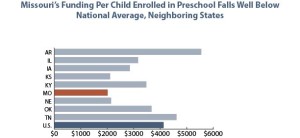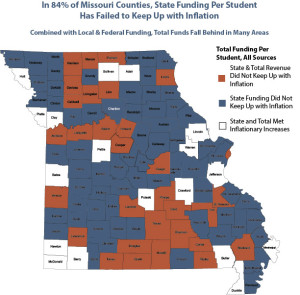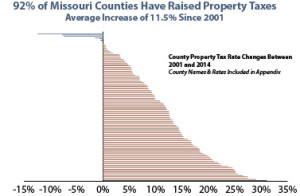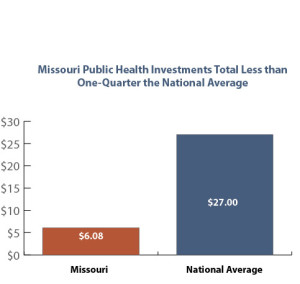We previously provided some context as to how the revenue Missouri has to invest in the health and education of its residents compares to the revenue available in decades past.
Today, MBP provides a few data points on these specific issues. Further details can be found in our full Invest in Missouri report series.
From early education through college, the value of Missouri’s investments in our youth has diminished, potentially jeopardizing the long-term well-being of a generation of children.
- Since 2009, funding for Parents as Teachers has been cut in half.
- Access to child care assistance for low-income families is well below the national average, ranking 49th in 2014. The number of children receiving subsidized child care has fallen, despite increased child poverty.
- Missouri has cut state funding for child care assistance by 35% since budget year 2008, and our state ranks near the bottom in its funding for preschool.
In the current school year, the amount of funding provided through Missouri’s “Foundation Formula,” which distributes state support to local schools, remains $400 million under the statutorily required level.
- Had state funding increased at the same rate as inflation between the 2001 and 2014 school years, state funding would have been $361 million greater in FY 2014. That’s the equivalent of our local schools having an additional $554 per student to enhance educational opportunities.
- Between the 2000-2001 and 2013-2014 school years, state funding for local schools increased by 22.7 percent. However, that growth rate fell well below the inflation rate over the same period of 34 percent. As a result, the real value of state funding has declined.
- In five out of every six counties, the amount of state funding provided per student failed to meet inflationary cost increases.
- Local governments have had to shoulder increased responsibility for funding education in their communities. As a result, 92% of counties raised property taxes during that time, setting the stage for enhanced funding disparities among districts.
- Funding for public four year higher education has dropped since 2009, and tuition and fees have risen by nearly 15 percent.
- Unsurprisingly, over the same timeframe, debt for Missouri students has also increased, rising by about 23 percent between 2008 and 2013.
- Although one in ten Missouri adults have a serious mental illness, 40 percent of those go without treatment. Yet Missouri cut state general revenue funding for mental health services by as much as 35 percent since 2009.
- Missouri’s spending on public mental health services at $99.40 per capita is well below the national average of $119.62 per capita.
- Reimbursement rates for the Department of Mental Health’s community providers have fallen far behind inflation, making it harder for providers to maintain proper staffing and services.
- If left untreated, serious mental illness can escalate and result in premature death, increased incarcerations, create burdens to county jails and law enforcement agencies, and increased costs for Missouri taxpayers.
- Missouri ranks 50th in the nation in the amount of funding it provides to public health. And the public health infrastructure is what we rely on to monitor and detect disease outbreaks.
- Missouri spends less than one-fourth the amount that most other states spend on public health services. Missouri spends just $6.08 per person in state funding for public health, while the national median amount is $27.40.
- In 1990, Missouri was ranked as the 24th healthiest state, but by 2014 Missouri dropped to 36th in the nation.
- Investments in local public health agencies have been cut by nearly two-thirds since 2001.
One in nine Missourians is uninsured, yet Missouri’s eligibility for Medicaid is third-lowest in the nation. In 2005, Missouri made dramatic cuts to its Medicaid program, causing 100,000 Missourians to lose their health care coverage. The cuts to eligibility remain today. As a result, parents in a family of three that earn more than $301 a month are not eligible for Medicaid in Missouri.
While Missouri’s uninsured rate dropped about 25 percent over the last two years, other states have experienced much higher declines in their uninsured rates over the same period. Nationwide, the decline in the uninsured is largely attributable to two provisions within the federal Affordable Care Act, including implementation of Medicaid expansion and state health exchanges.
States that implemented both measures averaged drops of 44 percent in the number of uninsured in their state. Passing Medicaid expansion in Missouri would close a gap in overage for about 300,000 Missourians, improving the reliability of employees for businesses, and providing a net savings of about $100 million in state general revenue annually for the state.









